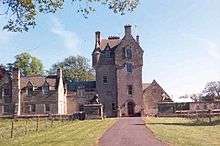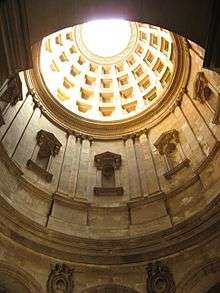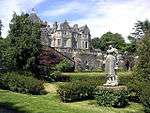David Bryce

David Bryce FRSE FRIBA RSA (3 April 1803 – 7 May 1876) was a Scottish architect.
Life
Bryce was born in Edinburgh, where his father was a successful builder.[1] He was educated at the Royal High School and joined the office of the architect William Burn in 1825, at the age of 22. By 1841, Bryce had risen to be Burn's partner. Burn and Bryce formally dissolved their partnership in 1845, with disputes over the building of St Mary's Church, Dalkeith, Midlothian, for the Duke of Buccleuch.
Burn moved to London, and Bryce succeeded to a very large and increasing practice, to which he devoted himself with the enthusiasm of an artistic temperament and untiring energy and perseverance. In the course of a busy and successful career, which was actively continued almost down to his death, he attained the foremost place in his profession in Scotland, and designed important works in most of the principal towns of the country. [1]
In the 1830s Bryce was living at 8 Great Stuart Street on the prestigious Moray Estate in Edinburgh's West End.[2]
In 1835 he was elected an associate of the Royal Scottish Academy, and in the following year became an academician. He was also a fellow of the Royal Institute of British Architects, of the Architectural Institute of Scotland, of the Royal Society of Edinburgh, and officiated for several years as grand architect to the Grand Lodge of Masons in Scotland. He died on 7 May 1876, after a short illness from bronchitis, leaving many important works in progress, which were completed under the superintendence of his nephew, who had been his partner for some years, and who succeeded to his business. He died unmarried. [1]
He is buried in the New Calton Cemetery in Edinburgh just west of the main north-south path,[3] beside his nephew, John Bryce, also an architect, who worked with him in later life. David Bryce never married.[4]
Assessment
Bryce worked in all styles, and at first chiefly in the so-called Palladian and Italian Renaissance, but he soon devoted himself more exclusively to the Gothic, particularly that variety of it known as Scottish Baronial, of which he became the most distinguished and the ablest exponent. It was in this style that his greatest successes were achieved, particularly in the erection and alteration of mansion houses throughout the country, of which at least fifty testify to his sound judgement in planning, and to his appreciation of its opportunities for picturesque effects.
The best of his public buildings in this style are probably Fettes College and the Royal Infirmary in Edinburgh; while the buildings of the Bank of Scotland, which so largely contribute to the beauty of the outline of the Old Town of Edinburgh, exhibit him at his best in the Italian style. His fame is, however, mainly due to his ability in reviving the picturesque French Gothic, now naturalised in Scotland under the name of Baronial; the annual report of the Royal Scottish Academy in the year of his death said "there is no doubt that his name will long be honourably associated with much that is best and most characteristic in the domestic architecture of later times". [1]
With commissions for over 230 buildings during his career, Bryce is best known for perfecting the Scottish Baronial style, with which he pioneered the development of large and loosely planned country houses, for example Craigends House in Renfrewshire. His designs drew inspiration from 16th century Scottish architecture, including crow-stepped gables, turrets and carved doorways.
In his banks and public buildings, he preferred to use Italianate classical styles similar to those of Charles Barry - his design for Fettes College, Edinburgh was one of the first to revive the French château style. Several other architects trained under Bryce including Sir James Gowans, William Hamilton Beattie and James Campbell Walker.
List of architectural works


- Newton Hall, by Kennoway, Fife, (1829). Bryce's first known independent commission.
- St. Marks Unitarian Church, Castle Terrace, Edinburgh (1834)
- Caledonian Insurance Company, 19 George Street, Edinburgh (1840)
- Luscar House, Gowkhall, Fife (1842)
- Life Association of Scotland building, Princes Street, Edinburgh (demolished) (1843)
- Contributed to St Mary's Church, Dalkeith Palace, Midlothian (1844–54)
- Refit of interior to west end of Greyfriars Kirk (New Greyfriars) following a severe fire (1845).
- Headquarters of the British Linen Bank in St Andrew's Square, Edinburgh (1846)
- Completion of Hamilton Mausoleum (1848)
- Supervision of the dismantling stone by stone of Trinity College Church to make way for the building of Waverley Station in Edinburgh (1848)
- Clifton Hall School, Edinburgh (1850)
- Kimmerghame House, Berwickshire (1851–53)
- Panmure House, Angus (1852–55)
- Balfour Castle, Orkney (1853)
- Surgical Hospital, High School Yards Edinburgh (1853)
- The Royal Exchange, Dundee (1854-1855)
- The Glen, Scottish Borders (1854–1855)
- Torosay Castle, Isle of Mull (1856)
- Shambellie House, Dumfriesshire (1856)
- Craigends House, Houston, Renfrewshire (demolished) (1857)
- Eastbury Park, Northwood (demolished) (1857)
- Eaglesham House 1859-
- Craigflower House, Torryburn, Dunfermline (1860)
- Life Association of Scotland, 40-41 Dame Street, Dublin, Ireland (1861-64)[5]
- Dalmore House, Stair, East Ayrshire (1864–70)
- Redesign of the headquarters of the Bank of Scotland, The Mound, Edinburgh (1864–71)
- Glenapp Castle, Ballantrae, Ayrshire (1870)
- Fettes College, Edinburgh (1870–73) designed 1864.
- Edinburgh Royal Infirmary's former building by the Meadows (1870–79)
- Trumland House, Orkney (1876)
- Edinburgh branch of the Union Bank of Scotland (now pub restaurant The Standing Order), George Street (1876)
- Newliston, Lothian (Neoclassical wings added to main house built by Robert Adam) and Scottish Baronial gatehouse (dates unknown).
Gallery of architectural work
-

St. Mary's Church, Dalkeith Park
-

Former British Linen Bank, St. Andrew Square
-

Statues on the British Linen Bank building
-

Hamilton Mausoleum, exterior
-

Hamilton Mausoleum, interior
-

Bank of Scotland Head Office
-

Bank of Scotland Head Office on the Mound
-

Bank of Scotland Head Office, seen from Market Street
-

Fettes College, Edinburgh
-
Fettes College Chapel detail
-

Clocktower of the Royal Infirmary, Edinburgh
-

Hospital wards of the Royal Infirmary
-
Bryce's bank on the corner of George St and Hanover St Edinburgh
-

Bryce's gatehouse at Newliston
References
- 1 2 3 4 Burnet 1886.
- ↑ http://digital.nls.uk/directories/browse/pageturner.cfm?id=83399907&mode=transcription
- ↑ Waterston, Charles D.; Macmillan Shearer, A (July 2006). Former Fellows of the Royal Society of Edinburgh 1783-2002: Biographical Index (PDF). I. Edinburgh, UK: The Royal Society of Edinburgh. ISBN 978-0-902198-84-5. Retrieved December 27, 2010.
- ↑ Profile, royalsoced.org.uk; accessed 17 June 2015.
- ↑ http://www.dia.ie/works/view/34551/building/CO.+DUBLIN%2C+DUBLIN%2C+DAME+STREET%2C+NO.+040-41+%28LIFE+ASSOCIATION+OF+SCOTLAND%29
- Attribution
![]() This article incorporates text from a publication now in the public domain: Burnet, George Wardlaw (1886). "Bryce, David". In Stephen, Leslie. Dictionary of National Biography. 7. London: Smith, Elder & Co. p. 158.
This article incorporates text from a publication now in the public domain: Burnet, George Wardlaw (1886). "Bryce, David". In Stephen, Leslie. Dictionary of National Biography. 7. London: Smith, Elder & Co. p. 158.
